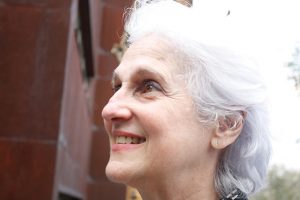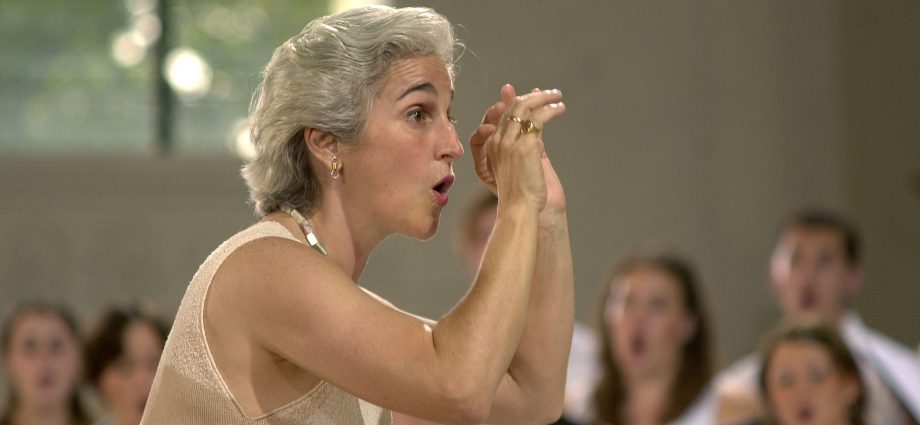María Guinand, conductor, Venezuela
There is no doubt that the success of directors depends on many factors such as their musical preparation, their selection of repertoire, their testing methodology, the leadership to form a good choral group, vocal work and many other variables. However, many times we observe conductors who, having all of these skills, are inexpressive and little communicative. The problem is that they haven’t conceded importance to body language and gestures, which they must develop cautiously and carefully.
In this short piece of writing I am going to try to address this fascinating topic. Why is it important to develop a language of gestural/bodily codes that are fundamental to the communication between choral conductor or orchestral conductor and will definitively impact the interpretation of the music.
The great actor Vittorio Gassman wrote:
‘It is true that gesture is one of the most specific signs of an actor’s personal language. A gesture (it is the first thing I teach my students), a broad or barely perceptible gesture, always precedes the word, it is the one that enunciates the expressive intention, the emotional will’.
Alberto Grau states in his book “La Forja del Director” (“The Forging of the Director”):
‘Gestures allow the conductor to communicate with his group both technically and expressively. Gestural movements constitute codes that allow the choral ensemble to decipher the meaning of the work, its internal rhythm, its expressive nuances, hence the gesture must be immediately recognised by the choir, be explicit to avoid confusion, and adaptable to various situations that may arise due to the dimensions of the rehearsal room or the stage for the performance, as well as the number of members present in the ensemble’.
For this reason, gesture is a fundamental aspect of conducting, which must be practised and learnt conscientiously, and for this the conductor must work on it assiduously and perfect it. To do this, we must know our body through physical preparation practices, especially the musculature, posture, fluidity and continuity of movement, strength and amplitude of movement, tension and distension. In short, all the elements that allow us to have an efficient and expressive gesture, which is a true channel of communication with the choir.
I think it is important to briefly explore some aspects of our muscular system, which are related to this subject.
The human muscular system is made up of a set of more than 650 different muscles, most of which can be controlled at will and allow us to exert sufficient force on the skeleton to move. These in turn are made up of cells called ‘myocytes’ with a high level of specificity, which make the muscle fibres resilient and elastic and therefore able to be subjected to stretching and compression.
The muscles we will use for the purposes of the director’s gesture are the skeletal or voluntary muscles that allow us the movement to use our limbs, move around and make gestures as simple as moving our eyes or smiling. The most relevant ones we need for everyday actions are:
Pectorals. …Trapezius muscles. …Quadriceps. …Abdominals. …Biceps. …Triceps.
Of all these, for the purposes of our gesture the most important are the pectoral and abdominal muscles as they help us to have a balanced body structure, the deltoids and trapezius muscles have a relevant influence on the movement of the shoulders and arms. Also the facial muscles that control our expressions.
Other aspects that should be briefly mentioned are the classification of the muscles in order to understand how to use and train them (basically into flexors, extensors, rotators and stabilisers)[1], muscle tone[2], types of fibres[3] and their contractions[4].
From all of the above it can be deduced that performing a certain movement is a complex action in which different muscles with different functions must act in a coordinated way, although there may be one that is the main one.
In my experience, I organise my daily body exercise routines around my dance classes and Tai Chi sessions, as well as silent but active walks. These routines allow me to be prepared to then tackle specific preparatory exercises for directing.
Building a series of postural, relaxation, strengthening, tension and muscle relaxation exercises is essential before tackling the fundamental aspects of the technique of the gesture. This will allow us to get to know our body, its possibilities, its weaknesses and to build our own expressive language. It is also very important to work consciously on facial expression and to accompany it with body movements that reiterate it.
In the study and practice of the technique of direction, in addition to the aspects related to the figures of direction and their clarity, we must deal with other aspects that depend directly on a precise and clear gesture.
Each conductor develops a kind of individual choreography which must be sufficiently clear to be understood by all the groups he or she has to conduct.
The relationship of movement to maintain a constant tempo will depend on good muscular tension and relaxation of the arm, as well as precision in the marking of the phrasing and articulations. Likewise the proper handling of dynamics depends on the extension and tension of the gesture; making a gradual diminuendo or crescendo is related to muscular tension or distension, as well as the sudden change of dynamics.
Superfluous gestures undoubtedly hinder the musical discourse.
A gesturally differentiated direction appropriate to the musical discourse must be carefully studied and prepared in conjunction with the analytical-musical study of a score and be related to the expressive and emotive capacity to convey the message of the musical work.
[1] Flexors (used for flexion), extensors (extension), rotators (supination and pronation), abductors (for separation), stabilisers or fixators (their aim is to maintain muscle tension). Or their classification into antagonists (they oppose the action of the corresponding movement), agonists (same movement), synergists (also in favour of the action of the muscle, but indirectly).
[2] It is also called muscular tension and is the partial, passive and continuous contraction of the muscles that decreases with the sleep phase. It plays a major role in the maintenance of posture. Under normal conditions, muscle tone is maintained unconsciously and without fatigue through the activity of the nervous system.
[3] Type 1: Also called slow twitch or red fibres. They are small in diameter and are supplied by a large number of blood vessels. They function mainly for activities that require contractions of low intensity but very prolonged in time, for example the maintenance of body posture.
Type 2: Also called fast twitch or white. They have the opposite characteristics to type I fibres, their diameter is larger and they are poorly vascularised. The organism uses them mainly for short-lasting exercises, but of high intensity. They are very sensitive to fatigue.
Type 3: They have intermediate characteristics between type I and type II. Depending on the type of training performed by a person, they can be transformed into type I fibres, if prolonged strength exercises predominate, or into type II fibres.
[4] Isometric contraction: In this type of contraction the length of the muscle fibre remains almost constant, but the muscle tone is intensified and no displacement occurs. An example is the contraction that takes place in the muscles of the lower limbs and those in the vicinity of the spine to maintain an upright posture.
Isotonic contraction: In this type of contraction the length of the muscle fibre is modified by shortening, but the muscle tone remains almost constant and displacement occurs. An example is the muscle contraction performed to lift an object and change its position.
 María Guinand, choral and orchestral conductor, university professor, pedagogue and leader of choral projects, is currently Artistic Director of the Schola Cantorum Foundation of Venezuela and the Choir of the Polar Foundation. In her long career, she has been the Associate Professor of the Simón Bolívar University (1976-2018) (Venezuela); Coordinator of Choral Symphonic projects of El Sistema (1980-2012); and Artistic Director (2003-2017) of the ‘Música para Crecer’. She has also been President (e), Vice President and Advisor for Latin America of the International Federation for Choral Music (1996-2014) (2019-) and a member of the International Music Council (UNESCO) (2002-2005). She has won the following awards: ‘Kulturpreis’ (1998), ‘Robert Edler Preis für Chormusik’ (2000), Helmuth Rilling Award (Internationale Bachakademie 2009), the Life Achievement Award of the International Federation for Choral Music (FIMC 2019) and the Honorary Doctorate of the Metropolitan University, Caracas, Venezuela (2020). She is frequently invited as a guest conductor, teacher and jury member in the USA, Canada, Latin America, Europe and Asia. Email: mariaguinand@gmail.com
María Guinand, choral and orchestral conductor, university professor, pedagogue and leader of choral projects, is currently Artistic Director of the Schola Cantorum Foundation of Venezuela and the Choir of the Polar Foundation. In her long career, she has been the Associate Professor of the Simón Bolívar University (1976-2018) (Venezuela); Coordinator of Choral Symphonic projects of El Sistema (1980-2012); and Artistic Director (2003-2017) of the ‘Música para Crecer’. She has also been President (e), Vice President and Advisor for Latin America of the International Federation for Choral Music (1996-2014) (2019-) and a member of the International Music Council (UNESCO) (2002-2005). She has won the following awards: ‘Kulturpreis’ (1998), ‘Robert Edler Preis für Chormusik’ (2000), Helmuth Rilling Award (Internationale Bachakademie 2009), the Life Achievement Award of the International Federation for Choral Music (FIMC 2019) and the Honorary Doctorate of the Metropolitan University, Caracas, Venezuela (2020). She is frequently invited as a guest conductor, teacher and jury member in the USA, Canada, Latin America, Europe and Asia. Email: mariaguinand@gmail.com
Translated by Rebeka Angstmann, UK

